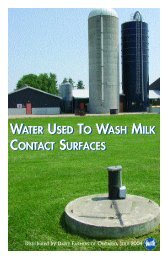Canadian Quality Milk On-Farm Food Safety Program - Centre ...
Canadian Quality Milk On-Farm Food Safety Program - Centre ...
Canadian Quality Milk On-Farm Food Safety Program - Centre ...
Create successful ePaper yourself
Turn your PDF publications into a flip-book with our unique Google optimized e-Paper software.
4.7 SUMMARY OF HAZARDS AND BEST<br />
MANAGEMENT PRACTICES<br />
<strong>Canadian</strong> <strong>Quality</strong> <strong>Milk</strong><br />
HAZARD SOURCE BEST MANAGEMENT PRACTICES<br />
Residues of<br />
livestock<br />
medicines or<br />
chemicals or<br />
vNHPs in milk and<br />
meat<br />
Broken needles in<br />
meat<br />
• Livestock<br />
medicines or<br />
chemicals or<br />
vNHPs improperly<br />
stored<br />
• Improper use of<br />
livestock<br />
medicines or<br />
chemicals or<br />
vNHPs<br />
Systemic<br />
Intramammary<br />
<br />
<br />
Topical<br />
treatments<br />
Feed<br />
• Intramuscular and<br />
subcutaneous<br />
injection of<br />
livestock<br />
medicines<br />
CHEMICAL<br />
Store and handle livestock medicines in a way that will<br />
not contaminate milk, meat or feeds.<br />
Store livestock treatments and needles in a clean and<br />
sanitary manner and according to label directions.<br />
Store medicines and chemicals intended for use in<br />
non-lactating and lactating dairy cattle and products<br />
not intended for dairy cattle in separate cupboards,<br />
shelves or areas (if stored on same shelf).<br />
Use only livestock medicines (including medicated foot<br />
baths) approved in Canada for use in dairy cattle.<br />
Use livestock medicines and pesticides according to<br />
the label or written instructions from a veterinarian or<br />
use products listed in Section 5 of the Permitted<br />
Substances Lists for Livestock Production<br />
(CAN/CGSB-32.311-2006) according to the<br />
specifications indicated.<br />
Create a drug listing or catalogue of all medications<br />
and chemicals used on livestock including product<br />
name and storage location.<br />
Mark all treated cattle in the milking herd that have<br />
milk withdrawals (e.g. leg bands).<br />
Maintain a permanent written record of livestock<br />
treatments.<br />
Have an SOP for treating animals.<br />
Have a corrective action plan in case an animal is<br />
treated incorrectly.<br />
PHYSICAL<br />
Record the animal and site of the broken needle.<br />
<br />
<br />
<br />
<br />
<br />
Have a veterinarian remove the broken needle ⎯ if<br />
this is not possible; inform packing plant or next buyer<br />
of broken needle.<br />
Have a written plan to deal with the situation where a<br />
treated animal or an animal with a broken needle has<br />
been sold and the next buyer was not informed?<br />
Use recommended tools and techniques when<br />
administering injections.<br />
Ensure animal to be injected is properly restrained.<br />
Use subcutaneous route to administer medications by<br />
injection if label permits.<br />
4—24<br />
June 2010
















